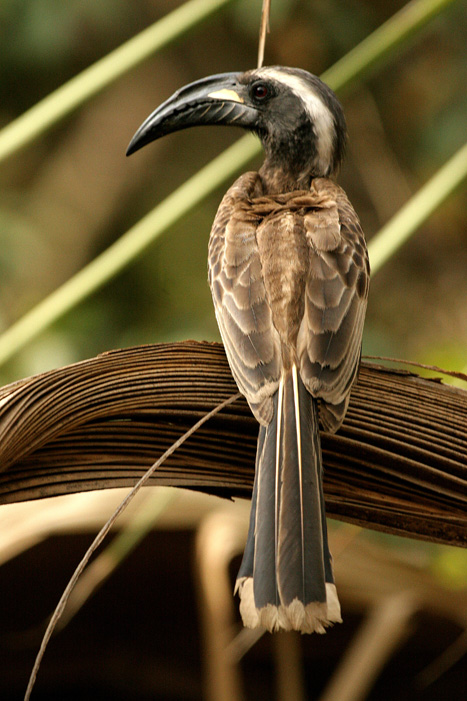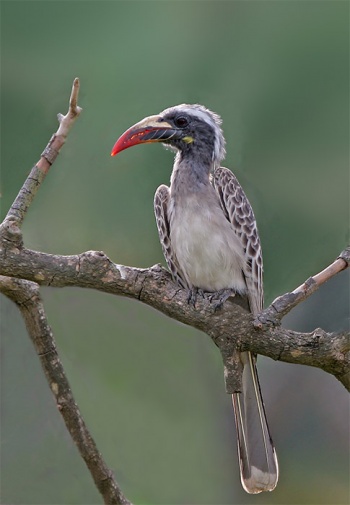(Video link. Reference updated) |
(genus change (Clements and IOC)) |
||
| Line 1: | Line 1: | ||
[[Image:Grey hornbill 2 edited-2.jpg|thumb|550px|right|Male<br />Photo by {{user|obasanmi|obasanmi}}<br />[[Gambia]], June 2007]] | [[Image:Grey hornbill 2 edited-2.jpg|thumb|550px|right|Male<br />Photo by {{user|obasanmi|obasanmi}}<br />[[Gambia]], June 2007]] | ||
| − | ;[[:Category: | + | ;[[:Category:Lophoceros|Lophoceros]] nasutus |
==Identification== | ==Identification== | ||
45cm.<br /> | 45cm.<br /> | ||
| Line 16: | Line 16: | ||
[[Image:African_Grey_Hornbill.jpg|thumb|350px|right|Female<br />Photo by {{user|Reini|Reini}}<br />Photographed: [[The Gambia]]]] | [[Image:African_Grey_Hornbill.jpg|thumb|350px|right|Female<br />Photo by {{user|Reini|Reini}}<br />Photographed: [[The Gambia]]]] | ||
==Taxonomy== | ==Taxonomy== | ||
| − | '' | + | ''Lophoceros nasutus'' has 2 subspecies<sup>[[#References|[1]]]</sup> |
| − | + | *''L. n. nasutus'': | |
| − | *'' | ||
*:[[Senegambia]] to [[Ethiopia]], [[Kenya]] and [[Uganda]]; [[Arabian Peninsula]] | *:[[Senegambia]] to [[Ethiopia]], [[Kenya]] and [[Uganda]]; [[Arabian Peninsula]] | ||
| − | *'' | + | *''L. n. epirhinus'': |
:*Southern [[Uganda]] and south-eastern [[Kenya]] to northern [[South Africa]] | :*Southern [[Uganda]] and south-eastern [[Kenya]] to northern [[South Africa]] | ||
| + | Formerly placed in the genus ''[[:Category:Tockus|Tockus]]''. | ||
==Habitat== | ==Habitat== | ||
Riverine bush, acacia woodland and savannah. | Riverine bush, acacia woodland and savannah. | ||
| Line 29: | Line 29: | ||
Though often unobtrusive they tend to call at sunrise producing a long sorrowful piping wail which varies in speed but often rises to a crescendo when the bird's head is thrown back as its whole body trembles with the effort. | Though often unobtrusive they tend to call at sunrise producing a long sorrowful piping wail which varies in speed but often rises to a crescendo when the bird's head is thrown back as its whole body trembles with the effort. | ||
==References== | ==References== | ||
| − | #{{Ref- | + | #{{Ref-Clements6thAug15}}#Avibase |
#Wikipedia | #Wikipedia | ||
{{ref}} | {{ref}} | ||
==External Links== | ==External Links== | ||
| − | {{GSearch| | + | {{GSearch|Hornbill+nasutus}} |
<br /> | <br /> | ||
{{Video|African_Grey_Hornbill}} | {{Video|African_Grey_Hornbill}} | ||
| − | [[Category:Birds]] [[Category: | + | [[Category:Birds]] [[Category:Lophoceros]] [[Category:Videos]] |
Revision as of 16:40, 27 August 2015
- Lophoceros nasutus
Identification
45cm.
- Grey body, head, flight feathers and long tail are darker
- White line down each side of the head and one on the back (visible only in flight)
- Long curved bill (black in male, female has red mandibles)
- Small casque and a creamy horizontal stripe.
Immature birds are more uniformly grey.
Distribution
Africa and the Arabian Peninsula
Western Africa: Mauritania, Senegambia, Senegal, The Gambia, Guinea-Bissau, Guinea, Mali, Sierra Leone, Liberia, Ivory Coast, Burkina Faso, Ghana, Togo, Benin, Nigeria, Niger, Chad, Cameroon, Central African Republic, Equatorial Guinea, Gabon, Congo, Angola
Eastern Africa: Sudan, Eritrea, Ethiopia, Somalia, Kenya, Uganda, Rwanda, Burundi, Tanzania, Zambia, Mozambique, Malawi
Southern Africa: Namibia, Botswana, Zimbabwe, South Africa, KwaZulu-Natal, Swaziland
Middle East: Arabian Peninsula, Saudi Arabia, Yemen
Taxonomy
Lophoceros nasutus has 2 subspecies[1]
- L. n. nasutus:
- Senegambia to Ethiopia, Kenya and Uganda; Arabian Peninsula
- L. n. epirhinus:
- Southern Uganda and south-eastern Kenya to northern South Africa
Formerly placed in the genus Tockus.
Habitat
Riverine bush, acacia woodland and savannah.
Behaviour
2-4 white eggs are laid in a tree hollow, which is blocked off during incubation with a cement made of mud, droppings and fruit pulp. There is only one narrow aperture, just big enough for the male to transfer food to the mother and the chicks. When the young and the female are too big to fit in the nest, the mother breaks out and rebuilds the wall, then both parents feed the young.
Vocalisation
Though often unobtrusive they tend to call at sunrise producing a long sorrowful piping wail which varies in speed but often rises to a crescendo when the bird's head is thrown back as its whole body trembles with the effort.
References
- Clements, J. F., T. S. Schulenberg, M. J. Iliff, D. Roberson, T. A. Fredericks, B. L. Sullivan, and C. L. Wood. 2015. The eBird/Clements checklist of birds of the world: v2015, with updates to August 2015. Downloaded from http://www.birds.cornell.edu/clementschecklist/download/
- Avibase
- Wikipedia
Recommended Citation
- BirdForum Opus contributors. (2024) African Grey Hornbill. In: BirdForum, the forum for wild birds and birding. Retrieved 26 April 2024 from https://www.birdforum.net/opus/African_Grey_Hornbill
External Links





